Brda, Home of the Rebula Grape.
Can one truly understand a wine region without setting foot in its vineyards, feeling the soil, and conversing with the winemakers? It certainly adds a profound dimension to one’s knowledge, especially when delving into less familiar wine regions.
Recently the Brda Consortium hosted the prestigious ‘Brda, Home of Rebula’ event for the seventh time. Eleven winemakers from both the Slovenian and Italian sides of the border were in attendance, in honour of the grape variety Rebula. The event was further elevated by the presence of Gašper Čarman, Slovenia’s foremost wine expert, and Caroline Gilby MW, a prominent London-based wine writer with extensive knowledge about Central and Eastern European wines.
The day was rich in an immersive tasting program, insightful masterclasses, and a showcase how Rebula can produce exceptional wines. What follows is a report by our own Marc Roovers.
The Legacy of Rebula
Some grape varieties transcend their origins, gaining global recognition, while others stay deeply rooted in their native soils, shaped by history and circumstance. Rebula, also known as Ribolla Gialla, belongs to the latter group, a variety with deep historical significance that has been cultivated in the undulating, cross-border landscapes of Goriška Brda (Western Slovenia) and Collio (Italy) since at least the 13th century.
Through the 13th century, Rebula was among the world’s most prestigious wines, often gracing the tables of Venetian aristocracy. Its first mention was in 1296, when a dispute over the sale of ‘Rabola’ was settled by Pope Boniface VIII. The production of Rebula in Brda is first documented in 1336.
In 1751, the ‘Theresian Cadastre’ valued Rebula above all other white and red wines. The ‘Classification of Wines in the Princely County of Gorizia and Gradisca’ in 1786 further solidified Brda’s vineyards among the top three wine-producing regions.
Today, Brda is recognized as the homeland of Rebula, thanks to the tireless efforts of Zvonimir Simčič, a highly respected oenologist and former head of the Goriška Brda Cooperative Cellar (now Klet Brda). Simčič was a key figure in the preservation, development, and promotion of Rebula at a time when international varieties were gaining dominance.
Up until the end of World War II, the Brda hills formed a single, united region. However, the post-war division of the area left it split between two countries. In 2004, Slovenia’s accession to the European Union erased this divide, reuniting the land of Rebula. Today, this cross-border terroir draws global attention, with ambitious producers from both sides working harmoniously on a shared viticultural heritage.

Brda and Collio: two distinct faces of a shared terroir
Brda and Collio have been the ancestral home of Rebula for centuries. The grape thrives on the region’s terraces, sculpted from the unique ‘opoka’ soil, where the Alpine and Mediterranean climates converge to create ideal growing conditions.
The Collio region has 1,400 hectares of vineyards across 200 producers. White grapes dominate 85% of plantings, led by Pinot Grigio, Sauvignon Blanc, and Friulano. Ribolla Gialla, native to the area, ranks fourth, covering 11% of the total.
In Brda, the focus is much more centered on Rebula. Its 1900 hectares of vineyards are tended by around 700 growers, with 74% of plantings dedicated to white grape varieties. Rebula accounts for 400 hectares, or 21% of the total, followed by Chardonnay, Friulano, and Pinot Grigio.
During the off-road tour in the winemakers’ jeeps, winding through the hills and terraced vineyards of Brda, we not only experienced the rugged terrain firsthand but also gained valuable insight into the unique conditions of this remarkable wine region.
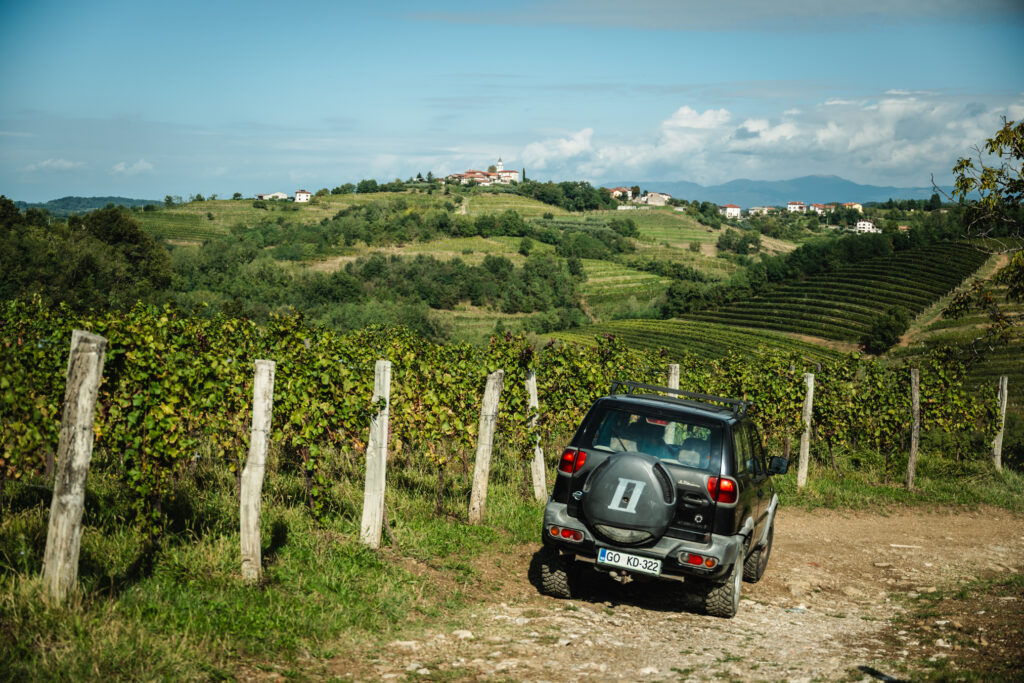
The soil here is primarily composed of Flysch, formed during the Eocene epoch, a geological period dating back 56 to 34 million years. At that time, much of modern-day Europe was submerged beneath a shallow sea. Sediments of clay and sand accumulated on the seabed, and the presence of marine life (such as shells) contributed to the formation of calcium-rich layers.
Tectonic movements lifted these sedimentary layers to the surface, tilting them at various angles, which enhanced water permeability and allowed erosion to break the rock down into finer fragments. Locally, this soil is referred to as ‘opoka’ in Slovenia and ‘ponca’ in Italy.
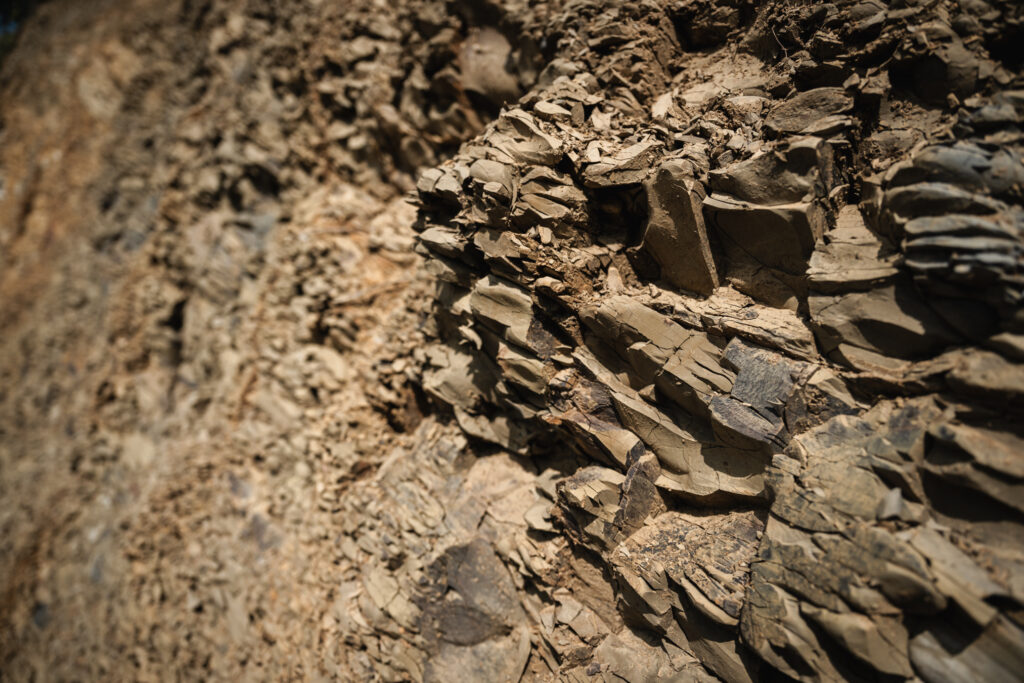
The region’s climate is a delicate balance between the mountains and the sea, rain and wind. Warm, moist breezes from the Adriatic Sea are tempered by the cool, dry Tramontana winds from the Julian Alps. This interplay creates a significant diurnal range, with warm days and cool nights. Located just 20 kilometers from the Adriatic coastline to the south and 20 kilometers from the foothills of the Alps to the north, Brda and Collio stand at the confluence of powerful climatic influences.
Mastering the terroir with Prof. Giovanni Bigot
During the masterclass led by Professor Giovanni Bigot, agronomist at the University of Udine, we delved into the distinctive terroir of the region.
The region’s climate, combined with terraced vineyards ranging in altitude from 100 to 350 meters, and nutrient-poor soils, creates a natural water deficit. As a result, the vines are forced to send their roots deep into the earth. It also stimulates the secondary metabolism of the grapevine with an increased production of resistance compounds.
These conditions directly contribute to the color, aroma, and texture of the wines. Vineyard management, expressed through the ratio of exposed leaf surface to grape yield (measured in kilograms of grapes), plays a critical role in achieving persistence and concentration in the wines.
Recent research also highlights the positive impact of fostering biodiversity in and around the vineyard on the complexity and longevity of the wines. In Brda, the vineyard-to-forest ratio stands at 1:3, further emphasizing the region’s commitment to maintaining a balanced ecosystem that enhances wine quality.
The discussion became even more intriguing when Professor Bigot elaborated on the color of the skin of ripe Rebula grapes. Color ripeness is a key factor that significantly influences the aromas and flavors of the final wine.
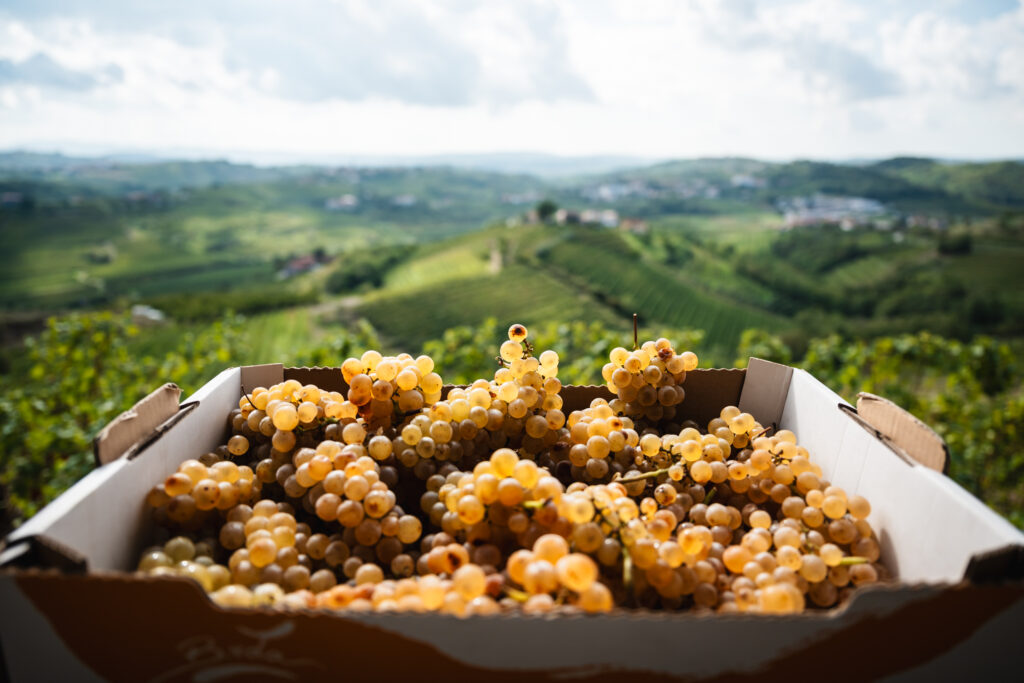
On unsuitable terroirs, such as flatlands or fertile, water-retentive soils, the grapes tend to develop more neutral phenolic or green aromas.
In contrast, water stress and high temperatures (above 35°C) on the terraced vineyards trigger the production of carotenoids and norisoprenoids in the grape skins. These compounds enrich the wine’s aromas with notes of yellow apple, white flowers, passion fruit, and tea leaves.
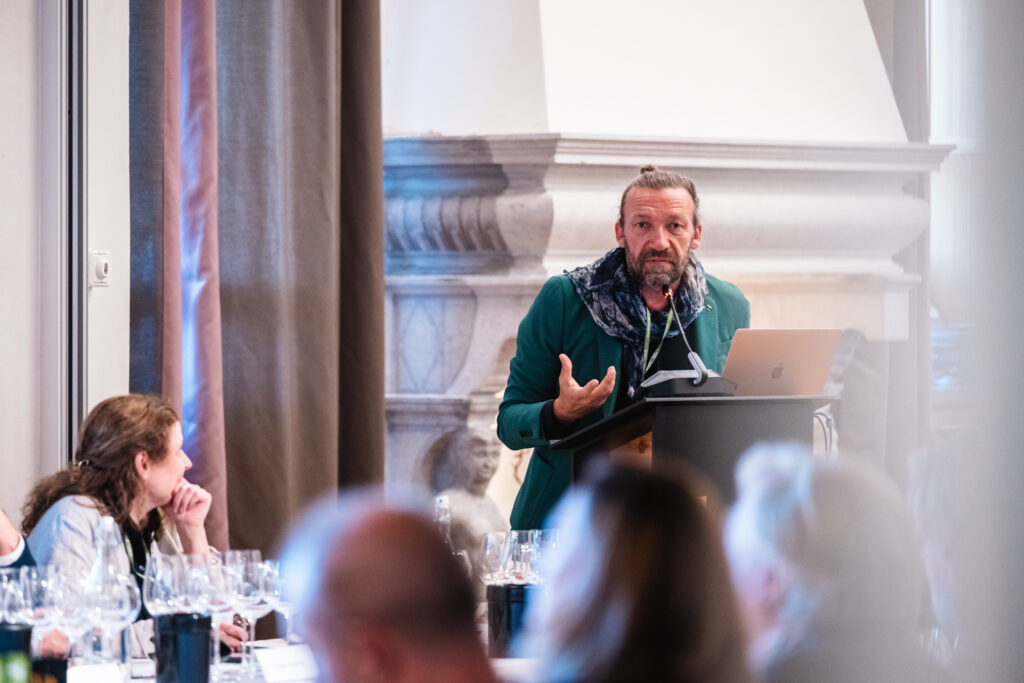
Professor Bigot concluded on a ‘hopeful’ note, observing that due to global warming, combined with drought conditions and the well-exposed hills and terraces, the typicity of Rebula has actually increased in recent years.
Grand Vertical Tasting of Rebula Wines
The Brda Consortium organized two tastings for the attendees, both moderated by TV presenter Mojca Mavec, with Gašper Čarman and Caroline Gilby MW providing commentary on the wines. The ‘Grand Vertical Tasting of Rebula Wines 2023-2020’ showcased 12 wines from the 11 winemakers present.
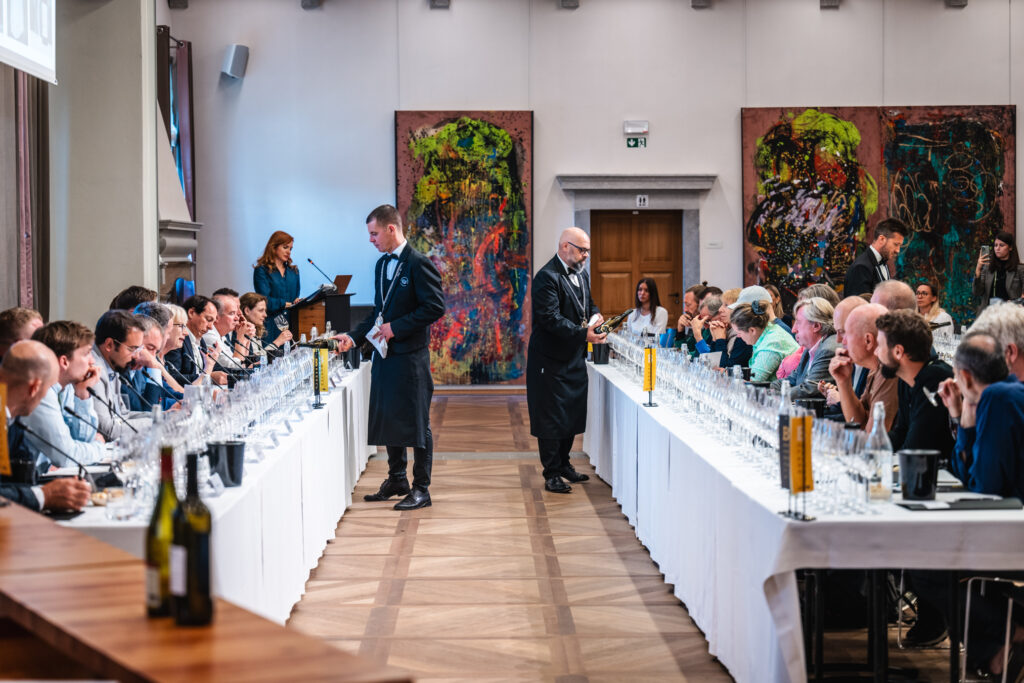
We began with three wines from the 2023 vintage: Dolfo Rumena Rebula 2023, Medot Rebula Journey 2023, and Jermann Vinnae Ribolla Gialla 2023. Among these mineral-driven wines, Silvio Jermann’s was the most vibrant, but the others also displayed high quality. An auspicious start.
The next five wines from 2022 highlighted the diversity of Rebula. Klet Brda Krasno Rebula 2022, from higher terraces between 200 and 300 meters, was defined by subtle oak aging that added breadth. Ščurek Rebula Up 2022 underwent 30% skin contact and 20 months in oak, resulting in notes of orange zest, tangerine peel, and exotic spices. Gradis’Ciutta Sveti Nikolaj Rebula 2022 offered a supremely elegant interpretation of Ribolla Gialla, with pronounced aromatics and minerality, a smooth mouthfeel of green pear and citrus, and a long finish. A standout wine.
Edi Simčič Fojana Rebula 2022 took it a step further. Aged for 11 months in barrique, the wine presented lightly oxidative notes, adding to its intensity and complexity. Aromas of white peach, mirabelle, and wild herbs with well-integrated oak complemented ripe peach, apricot, and quince on the palate, finishing with precise focus and length. Ferdinand Rebula Época 2022, from the single vineyard Smartno at 280 meters, was aged for 12 months on fine lees in 500- and 1000-liter barrels. Melon, apricot, and pear on the nose were followed by balanced juiciness with ripe lemon, acacia honey, and a long finish where the oak played a subtle role. This was one of our favourites!

Next, we moved to two wines from 2021. Vini Noüe Marinič is a collaboration between the Marinič family of Goriška Brda and Charles-Louis de Noüe of Domaine Leflaive in Burgundy. The Burgundy influence in the Erigone Ribolla Gialla 2021 was evident, with oak impressions from 12 months of aging in new 220-liter barriques.
Marjan Simčič Rebula Opoka Medana Jama Cru 2021, from a single cru on opoka soil at 200–250 meters and made by the president of the Brda Consortium, underwent 8 days of maceration and was aged in 1000-liter concrete eggs for 10 months, followed by 12 months in 2500-liter conical barrels. Floral honey, peach, dried orange peel, chestnut husk, and oriental spices were followed by ripe quince, lemon zest, and a slight tannic texture. A potpourri of citrus peels and dried flowers filled the long finish.
Klet Brda Bagueri Rebula 2020 and Erzetič Orbis Rebula 2020 closed the lineup. The wines from Klet Brda showed impressively. The grapes for Bagueri Rebula 2020 were picked overripe and aged on the estate for three years, with at least 12 months in 6000-liter foudres and barriques. Aromas of honey and vanilla cream, nuts, and juicy nectarine led to a surprisingly fresh attack with zesty lemon, nectarine, candied pineapple, and vivid citrus freshness. Creamy with a long-lasting finish, this was an exceptional wine. Erzetič Orbis Rebula 2020 spent 12 months in barrels of oak, mulberry, wild cherry, ash, and acacia, after which the wines were blended. Already showing some evolution, the wine exhibited spicy notes (pepper), orange marmalade, nuts, and honey, with a generous, creamy mouthfeel and a clear oak-driven finish.
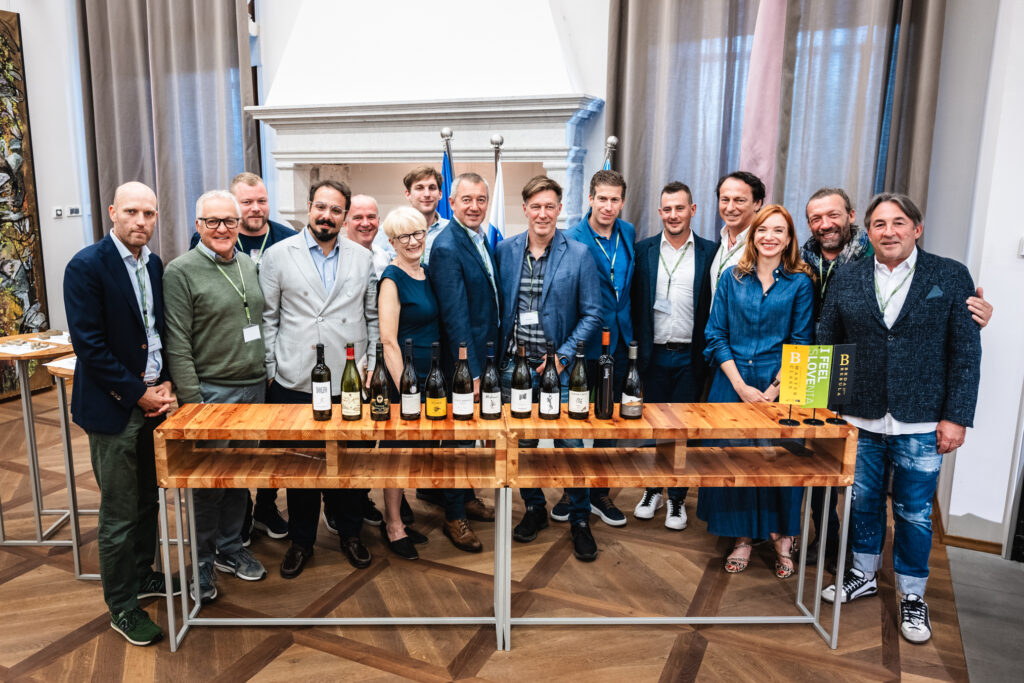
Vintage Masterpieces: The Beauty of Aged Rebula
During the ‘Interactive Wine Tasting: Various Styles of Rebula’-tasting, each producer presented two wines side by side, demonstrating the grape’s immense potential and the region’s diversity. We tasted 24 wines at a brisk pace, ranging from young (2023) to mature vintages from 2018 to 2014.
In his masterclass, Professor Bigot spoke about Rebula’s ability to produce carotenoids and norisoprenoids in the grape skins under optimal conditions. As a Riesling enthusiast, this immediately reminded Marc of the compounds responsible for the characteristic petrol aromas in aged Riesling. During a break, he asked Professor Bigot if this could also occur in older Rebula wines. He confirmed and added that with further aging, not only TDN (responsible for the petrol aroma) but also TPB, which can produce tobacco leaf aromas, could develop.
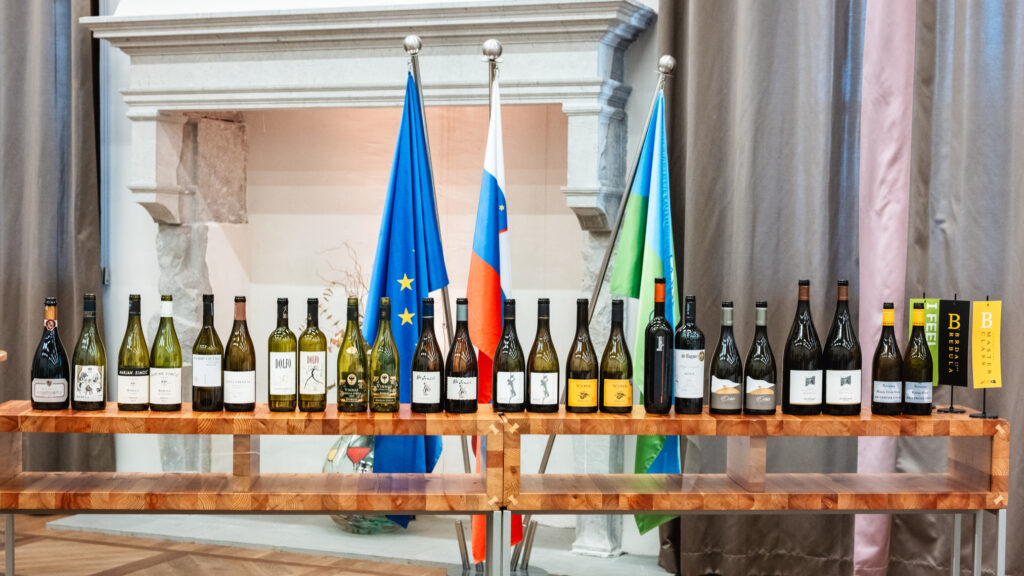
The two wines presented by Dolfo in the second tasting perfectly demonstrated what the professor had explained. Dolfo Rumena Rebula 2018 showed slight evolution with a fine hint of petrol, while Rumena Rebula 2015 displayed more evolved characteristics, with both a delicate petrol note and clear tobacco aromas.
Also noteworthy was the duo presented by Silvio Jermann. Vinnae Ribolla Gialla 2020, from a warm year that allowed the grapes to ripen to an amber color, contrasted with Vinnae Ribolla Gialla 2014, from a cooler year where the grape’s acidity took center stage. In the 2014, we detected a hint of tobacco leaves, but otherwise, there was little evolution, a testament to Jermann’s consistent use of screw caps.
The cooperative Klet Brda once again impressed with its wines in this series. We tasted Bagueri Rebula 2020from the first lineup alongside Motnik Rebula 2017. A fine hint of petrol was also present in the 2017, but the wine remained complex, with lemon zest, orange peel, fine acidity balanced with ripe stone fruit, and great length in the finish.
Ferdinand offered two other vintages of their Rebula Época. Winemaker Matjaž Četrtič presented the 2019 vintage, which revealed complex aromas of lemon and rhubarb, apricot, mirabelle, passion fruit, and quince. Precise acidity played with preserved citrus, orange segments, and mandarin. Rebula Época 2015, showing more evolution, again had a fine petrol note, with a phenolic, dense mouthfeel. Balanced acidity and green spices led to an intense finish that lingered with spices, herbs, and citrus zest. Both wines received high scores from us.
Finally, Silvio Jermann introduced his new project, surprising us with two barrel samples of the Sylvmann line. The first wine, Rebula Višvik-Višvik 2023 had 4 to 65 days of skin contact, while the second wine, Rebula-Višvik 2023 underwent 108 days of maceration. Both wines will be bottled by the summer of 2025. These are wines to savor in silence. Especially the wine with extended skin contact showcased tremendous complexity, with aromas of passion fruit, raisins, ripe peach, and grape skin. A phenolic, velvety texture in the mouth unfolded a spectrum of impressions—orchard fruit, citrus, dried fruits, salinity, and minerality. A promising project worth following closely.
Conclusion
The 7th Exclusive Rebula Wine Experience was more than just an event, it was a celebration of heritage, terroir, and winemaking mastery. Through immersive tastings, expert-led masterclasses, and a close examination of the unique Brda and Collio landscapes, we gained a deeper appreciation for the history and potential of Rebula. The wines, from fresh vintages to complex aged expressions, showcased the variety’s remarkable versatility and ability to evolve with grace.
While the global wine community pays increasing attention to Brda, the success of Rebula continues to grow, a true testimony to the commitment of winemakers on both sides of the border.
This article is written by our own Marc Roovers. We thank the organization of the Rebula Wine Experience, all producers and experts. Picture credits: Damijan Simčič – Zoso Foto and Marc Roovers.

